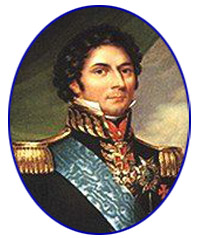

Click to see full text of the Chapter victor_ivanov@ukr.net
Argument of the Chapter
"Marshal Jean Baptiste Jules Bernadotte"
Early years. Joining military service. Royal Marines regiment of Brassac. Service on Corsica, in East India, captivity. Revolution. Promotion.
First independent command of brigade during the campaign of 1794. Successful battles with Austrians. Refusal from the rank of brigade general. Friendship with general Marceau. Participation in the battle at Flerus, seizure of fortress Maastricht. Fast way to the rank of division general. Bernadotte as the division commander Sambre-and-Maas army of Jourdan. Campaign in Germany 1796. Successful rearguard battle at Forchheim. General analysis actions Bernadotte during campaign of 1796. Service in Italian army of Bonaparte. First conflict with Napoleon. Success ¾ Tagliamento. Bernadotte as the governor of province Friol.
Participation in political intrigues. Bernadotte as the ambassador in Vien. Failure of diplomatic mission. Marriage with sister-in-law of NapoleonÆs brother. Command Lower Rhein observation army. Strategic preconditions of spring campaign of 1799 on Rhein, tasks of Bernadottes army. Bernadotte as the Minister of war in 1799. Analysis of his activities on the state post. Moral support of generals Moreau and Pichegru conspiracy by Bernadotte. Command of West Army, successful repulsing of British landings. Scandal with ½cans╗. Bernadotte as the governor of Hanover. Deputy State Counsil. MarshalÆs baton.
Beginning of Austrian campaign of 1805. Seizure of Munchen by marshal BernadotteÆ Corps. Crushing defeat of general KienhmaerÆs Austrian Corps. Sluggish of Bernadotte during attempt of encirclement Russian army on Danube. Unbelieveably fast transition before Austerlitz battle. Participation in ½lionÆs jump╗ ¢ strike of marshal Soult at Pratzen Heights. Hard battle with Russian Guard. Bernadotte as the governor of Ansbach. Title of the Duke of Ansbach and Prince of Ponte Corvo.
Campaign of 1806 against Prussia. Strategic plans of the sides. Senseless movements between Dornbourg and Apolda. Conflict of Bernadotte with marshal Davout. Napoleon nearly ordered to take Bernadotte to military tribunal. Encirclement of field marshal BluecherÆs reminders at Luebeck. Human treatment of captured Swedish soldiers. Polish Campaign 1806-1807. Strategic covering of Grand Army by BernadotteÆs Corps. Sudden advance of Russian army under command of general Bennigsen. Local victory over Russians at Mohrungen. Marshal Bernadotte shows his best tactical skills. Unsuccessful maneuvering and appearing to be late to battle at Preysisch-Eylau. Wound at Spanden and resignation. Bernadotte as the governor of Hanseatic cities. Strategic struggle with British on Jutland peninsula. The enemies manages to pull off the Spanish corps of marquis La Romana from under the nose of marshal Bernadotte.
Austrian Campaign 1809. Command of Saxon Corps. Participation in the battle of Wagram. Gascon bravade. Arbitrariness of Prince of Ponte Corvo on the second day of the battle. Removal from command. Return to Paris. Bernadotte as the commander of Antwerp army. Repulsing of British landing expedition at Walcheren. New disgrace.
Invitation to come to the throne. Departure to Sweden. Search of allies and development of behavior of struggle for supreme power. Bernadotte as the Swedish Prince of Crown. ½Pro╗ and ½Contra╗ of Swedish participation in anti-Bonaparte coalition. Diplomatic intimacy of Sweden and Russia. Conclusion of three-sides agreement between Russia, England and Sweden for mutual military actions against France. Ally treaties of Sweden with Austria and Prussia in exchange for gaining Norway. Landing of Northern army in Stralsund. Prudent tactics of waiting. Plans of becoming the King of France. Victory at Dennewitz. The battle against Saxon Corps of general Regnier at Leiptzig. End of campaign of the year 1813.
Development of plans of intervention to Norway. Occupation of Norway. Entering Swedish throne. Death. Analysis of military leaderÆs and political career of marshal Bernadotte.
Maps of the Chapter ōMarshal Jean Baptiste Jules Bernadotteö
1. LÆOrdre mixte, used by the French in battle at Tagliamento.
2. Campaign in Central Europe (September 1-25, 1805).
3. Battle at Austerlitz (December 2, 1805, 2:00 P.M.).
4. Situation at Jena (October 10-12, 1806).
5. Situation at Central Europe (January 31, 1807).
6. Europe, 1808.
7. Battle at Leiptzig.
Illustrations of the Chapter ōMarshal Jean Baptiste Jules Bernadotteö
1. Bernadotte -the Republican general.
2. Portrait of Desiree Clary.
3. Bernadotte - the Minister of War.
4. Marshal Bernadotte.
5. Portrait of William Pitt.
6. The Arms of Prince Ponte-Corvo.
7. Portrait of general Rivaud.
8. Portrait of Marquess La Romana.
9. The Spanish ArmyÆs uniforms:
Ģ Dragoon of the Sagunto Regiment;
Ģ Dragoon of the Villaviciosa Regiment;
Ģ Chasseur of the volunteer Regiment;
Ģ Chasseur of the Olivenza Regiment.
10. The Saxon ArmyÆs uniforms:
Ģ Grenadier of the PrinceÆs Frederic August Regiment;
Ģ Grenadier of the Life Guard;
Ģ Chasseur of the light infantry;
Ģ Artilleryman;
Ģ Guard cavalryman;
Ģ Cavalryman of PrinceÆs Clement Regiment;
Ģ Hussar.
11. Portrait of Minister Joseph Fouche.
12. Bernadotte ¢ Swedish Crown Prince.
13. Portrait of Russian Czar Alexander I.
14. Portrait of general Borstell.
15. The Swedish Royal Guard uniforms:
Ģ Rank of the Svea Life Guard;
Ģ Rank of the Finska Guard;
Ģ Rank of theLife Garde Til Haste;
Ģ Rank of the Guard cuirassier Regiment.
16. Portrait of general Langeron.
The structure of military-historical monograph
½Military campaigns of NapoleonÆs marshals╗
Preface.
Introduction.
Chapter 1 ¢ marshal Jean Baptiste Jules Bernadotte, Prince of Ponte Corvo (1763-1844).
Chapter 2 ¢ marshal Louis Alexander Berthier, Prince of Neuchatel, Prince of Walange, Prince of Wagram (1753 ¢ 1815).
Chapter 3 ¢ marshal Jean Baptiste Bessieres, Duke of Istria (1768-1813).
Chapter 4 ¢ marshal Guillaume-Marie-Anne Brune (1763-1815).
Chapter 5 ¢ marshal Victor Claude Victor-Perrin, Duke of Belluno (1764 ¢ 1841).
Chapter 6 ¢ marshal Laurent Gouvion Saint-Cyr, marquess (1764-1830).
Chapter 7 ¢ ņÓ°Óļ Emmanuel Robert de Grouchy, marquess (1766-1847).
Chapter 8 ¢ marshal Louis Nicolas Davout, Duke of Auerstaedt, Prince of Eckmuhl (1770-1823).
Chapter 9 ¢ marshal Jean Baptiste Jourdan, count (1762-1833).
Chapter 10 ¢ marshal Francois Etienne Christophe Kellermann, Duke de Valmy (1735-1820).
Chapter 11 ¢ marshal Jean Lannes, Duke of Montebello (1769-1809).
Chapter 12 ¢ marshal Francois Joseph Lefebvre, Duke of Danzig (1755-1820).
Chapter 13 ¢ marshal Jacques-Etienne-Joseph-Alexander Macdonald, Duke of Tarente (1765-1840).
Chapter 14 ¢ marshal Auguste Frederic Louis de Viesse Marmont, Duke of Ragusa (1774-1852).
Chapter 15 ¢ marshal Andre Massena, Duke of Rivoli, Prince of Essling (1758-1817).
Chapter 16 ¢ marshal Bon Adrien Jeannot Moncey, Duke of Conegliano (1754-1842).
Chapter 17 ¢ marshal Adolphe Edouard Casimir Joseph Mortier, Duke of Treviso (1768-1835).
Chapter 18 ¢ marshal Joachim Murat, King of Naples (1767-1815).
Chapter 19 ¢ marshal Michel Ney, Duke of Elchingen, Prince of Moskwa (1769-1815).
Chapter 20 ¢ marshal Pierre Francois Charles Augerau, Duke of Castiglione (1757-1816)
Chapter 21 ¢ marshal Dominique-Catherine Perignon, marquis de Grenade (1754-1818).
Chapter 22 ¢ marshal Joseph Antoine Ponyatovsky, prince of Poland (1763-1813).
Chapter 23 ¢ marshal Jean-Mathieu Philiber Serurier (1742-1819).
Chapter 24 ¢ marshal Nicolas Jean de Dieu Soult, Duke af Dalmatia (1769-1851).
Chapter 25 ¢ marshal Louis Gabriel Suchet, Duke of Albufera (1770-1826).
Chapter 26 ¢ marshal Nicolas-Charles Oudinot, Duke of Reggio (1767-1847).
Conclusions.
Literature.